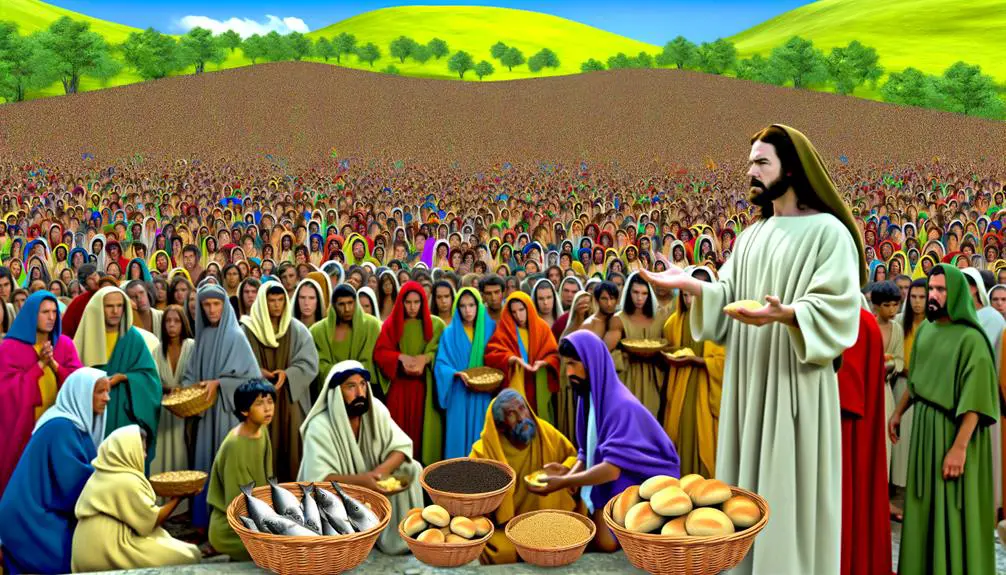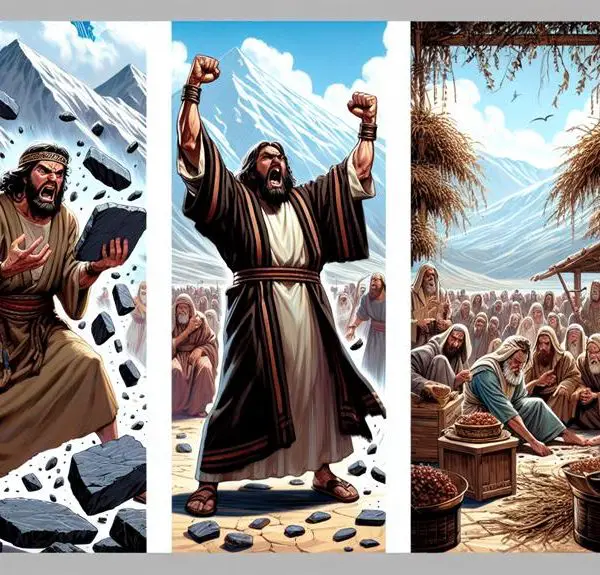Immerse yourself in biblical tales of kindness and learn how ancient acts of goodwill can inspire modern-day compassion and generosity.

Example of Good Works in the Bible
Imagine scrolling through your social media feed, only to stumble upon stories of incredible kindness and selflessness that date back thousands of years. You've likely heard of the Good Samaritan's unmatched compassion or the miraculous tale of feeding the five thousand.
These narratives aren't just ancient texts; they're blueprints for living a life filled with good deeds, compassion, and humility. As you ponder the relevance of these actions in today's world, consider how applying such timeless principles could reshape the way you interact with those around you.
Let's explore further, shall we?
Key Takeaways
- The Good Samaritan exemplifies compassion that crosses societal boundaries, teaching the value of empathy beyond differences.
- Jesus washing the disciples' feet models servant leadership and the importance of humility and service in community care.
- The miracle of feeding the five thousand illustrates divine provision and the power of faith to transcend human limitations.
- Dorcas' charitable acts highlight the significance of sustainable charity and community solidarity, inspiring future generations toward compassion.
The Good Samaritan's Compassion

The parable of the Good Samaritan exemplifies, through its portrayal of altruistic action, the profound impact of compassion in transcending societal divides. Within its cultural context, this narrative challenges the prevailing norms and prejudices of its time. You're invited to consider the Samaritan, not merely as a character within a tale, but as a representation of those marginalized by societal constructs, yet demonstrating an innate, universal capacity for empathy and kindness.
In analyzing this parable, it's crucial to acknowledge the historical enmity between Jews and Samaritans, which renders the Samaritan's actions not just unexpected but radical. This cultural backdrop enriches the story, illustrating how compassion can dismantle entrenched barriers of animosity and prejudice. It encourages you to look beyond superficial differences and recognize the shared humanity that binds all people together.
Drawing modern parallels, the essence of the Good Samaritan's compassion remains remarkably relevant. In today's global society, rife with division and strife, this parable serves as a potent reminder of the transformative power of empathy. It challenges you to confront your own biases and to act with kindness and understanding towards those who are different from yourself. The actions of the Good Samaritan provoke a reflection on how you can transcend societal divides, encouraging a culture of inclusivity and altruism.
Thus, the Good Samaritan's compassion, deeply embedded within its cultural context, continues to offer valuable insights into the human condition, urging a reevaluation of values in light of the enduring need for empathy and kindness in navigating contemporary societal challenges.
Feeding the Five Thousand

In examining the narrative of Feeding the Five Thousand, one encounters a profound demonstration of Jesus's ability to address physical hunger while also imparting spiritual nourishment, showcasing the multifaceted nature of his ministry. This account, found in all four Gospels, underlines not only a miraculous provision but also a significant faith demonstration by both Jesus and his disciples.
You observe that the logistics of this miracle—feeding thousands with merely five loaves and two fish—emphasize a divine provision that surpasses human understanding. This episode serves as a pivotal teaching moment for the disciples, as Jesus instructs them to distribute the food among the crowd. The act of breaking and sharing bread foreshadows the Last Supper, embedding a deeper spiritual meaning into this miraculous feeding.
The disciples' initial skepticism, followed by their participation, underscores a journey of faith. They witness firsthand how limited resources, when blessed by Jesus, can become abundant enough to meet the needs of a multitude. This transformation from scarcity to abundance mirrors the spiritual journey from doubt to faith, making the feeding of the five thousand a potent faith demonstration.
Moreover, the collection of twelve baskets of leftovers illustrates the principle of divine provision exceeding human needs. This detail not only highlights the miracle's logistics but also reinforces the idea that God's grace is boundless and available to all who seek.
The Widow's Offering

Shifting focus to another profound narrative, consider the Widow's Offering, where minimal monetary value contrasts with immense spiritual significance. This story, nestled within the New Testament, challenges societal perceptions and underscores the essence of heartfelt sacrifice. Through analytical lenses, let's dissect the core elements that render this account a pivotal example of good works in the Bible:
- Societal Perceptions of Wealth and Piety: The narrative unfolds in a temple setting, where the affluent make grand donations. Yet, it's the widow's meager offering—two small copper coins—that captures Jesus' attention. This juxtaposition highlights a critical examination of societal norms regarding wealth and the outward display of piety.
- The Measure of Sacrifice: Jesus points out that the widow, in her poverty, has contributed more than all others. They gave out of their abundance, but she, out of her scarcity, put in everything she had. This moment serves as a poignant commentary on the nature of sacrifice, emphasizing that the value of a gift lies not in its monetary worth but in the extent of the sacrifice it represents.
- Heartfelt Sacrifice vs. Obligatory Giving: The widow's action transcends the act of obligatory giving, showcasing a profound level of trust and devotion. Her contribution, though small, was a genuine expression of her faith and reliance on God's provision. This narrative invites readers to reflect on the depth of their own offerings, whether they stem from a place of heartfelt sacrifice or mere obligation.
In dissecting the Widow's Offering, we uncover layers of meaning that challenge and inspire. It's a narrative that speaks volumes about faith, sacrifice, and the true essence of giving, irrespective of societal perceptions.
Jesus Washing the Disciples' Feet

Embodied in Jesus' act of washing the disciples' feet, we find a profound lesson on humility and service, challenging traditional power dynamics and setting a precedent for leadership within the Christian faith. This act of servitude, often considered menial and beneath a person of high status, underscores the essence of servant leadership and cultural humility. By taking on the role of a servant, Jesus dismantles the hierarchical structures of his time, illustrating that true leadership is grounded in serving others.
Aspect |
Implication |
Relevance |
|---|---|---|
Role Reversal |
Jesus, as leader, performing a servant's task |
Challenges conventional views of power |
Cultural Humility |
Washing feet, a culturally lowly job |
Promotes understanding and respect across cultural divides |
Servant Leadership |
Leadership through service |
Offers a model for modern leadership theories |
Symbolic Gesture |
Cleansing as a metaphor for spiritual purity |
Encourages introspection and moral growth |
Community Building |
Act of service fostering unity |
Highlights the importance of mutual care in community |
This narrative not only invites reflection on the personal adoption of humility and service as virtues but also encourages a broader application of these principles in leadership and community engagement. In a world where power often corrupts, Jesus' example serves as a timeless beacon for those seeking to lead with integrity, compassion, and humility. Servant leadership and cultural humility, as demonstrated by Jesus, thus become not just ideals but practical approaches to fostering environments where everyone is valued and served equally.
Dorcas' Acts of Charity

Reflecting on another profound example of good works in the Bible, Dorcas' acts of charity demonstrate a commitment to community care and compassion. Known also as Tabitha, her story, chronicled in Acts 9:36-42, underscores the tangible ways in which individual acts of kindness can foster collective well-being. Dorcas' legacy, particularly through her sewing, offers a compelling narrative on the sewing significance and its potential for community impact.
Here are three key aspects that highlight the importance of Dorcas' endeavors:
- Empowerment through Provision: Dorcas utilized her skills in sewing to make garments for the widows in her community. This wasn't merely an act of charity but an empowerment strategy that addressed immediate needs, signaling a deep understanding of the socio-economic context she was part of.
- Community Solidarity: The response to Dorcas' death from the community illustrates the profound impact of her acts of charity. The display of garments to Peter by the widows not only showcased the tangible outcomes of her labor but also symbolized the collective mourning and appreciation. Her actions had knitted the community closer, fostering a sense of solidarity.
- Legacy and Inspiration: Dorcas' resurrection by Peter can be interpreted as a divine endorsement of her charitable works, inspiring future generations towards compassion and active community involvement. Her story underscores the enduring value of individual contributions to the collective health of a community.
In analyzing Dorcas' acts of charity, it's evident that her commitment transcended mere assistance; it was about sewing significance into the fabric of her community, thereby enhancing its resilience and unity.
Frequently Asked Questions
How Do Biblical Examples of Good Works Influence Modern Charitable Practices?
In analyzing how charitable motivations in biblical narratives influence modern philanthropy, you'll find that these ancient texts provide a foundational ethos. They've shaped the moral and ethical underpinnings of giving back, guiding individuals and organizations in their charitable endeavors today.
This historical connection enriches the context of modern philanthropy, encouraging a culture of generosity that mirrors the selflessness seen in biblical examples, thus reinforcing the importance of good works in contemporary society.
What Are the Theological Implications of Performing Good Works According to Different Christian Denominations?
Different Christian denominations grapple with the theological implications of performing good works, igniting the salvation debate.
You'll find that 82% of evangelicals believe in salvation through faith alone, contrasting with Catholic teachings emphasizing faith complemented by good works.
This divergence shapes their understanding and practice of charity, with each tradition interpreting the role of good deeds in salvation differently, reflecting a spectrum of beliefs within Christianity about the path to eternal life.
How Do Cultural and Historical Contexts Affect the Interpretation of Good Works in the Bible?
You'll find that cultural and historical contexts deeply influence how good works are interpreted in the Bible. Translation challenges and scriptural variations play critical roles. When texts move across languages, nuances can shift, altering meanings.
Additionally, the original context in which these texts were written affects understanding. Modern interpretations can diverge significantly from ancient intentions, leading scholars to constantly re-evaluate the implications of good works through these lenses.
In What Ways Do Non-Christian Religions or Belief Systems Have Similar Stories or Teachings About Acts of Kindness and Charity?
Across the board, you'll find that non-Christian religions and belief systems are rich with compassionate narratives and acts of kindness, mirroring the essence of interfaith cooperation.
These traditions offer a tapestry of stories where charity isn't just encouraged but exemplified.
Analyzing these narratives reveals a universal thread of empathy and altruism, illustrating that the impulse to help others transcends cultural and religious boundaries, fostering a global ethos of compassion and understanding.
Can the Concept of Good Works in the Bible Be Reconciled With Contemporary Issues of Social Justice and Activism?
Absolutely, you can reconcile the concept of good works with today's social justice and activism. By engaging in ethical consumerism, you're choosing products that align with moral and ethical standards, directly reflecting biblical teachings on kindness and responsibility.
Similarly, digital philanthropy allows you to support causes worldwide, mirroring the Bible's call to help those in need. These modern actions embody the spirit of biblical good works in today's context.
Conclusion
In analyzing these biblical accounts, one discerns a universal theme: selfless service transcends mere action, blossoming into a beacon of hope and compassion, much like a lighthouse guiding ships through treacherous waters.
These narratives underscore the profound impact of altruistic deeds, regardless of magnitude, demonstrating that true greatness lies not in power or wealth, but in the willingness to serve and uplift others.
Consequently, these examples offer invaluable insights into the essence of ethical conduct and moral responsibility.



Sign up